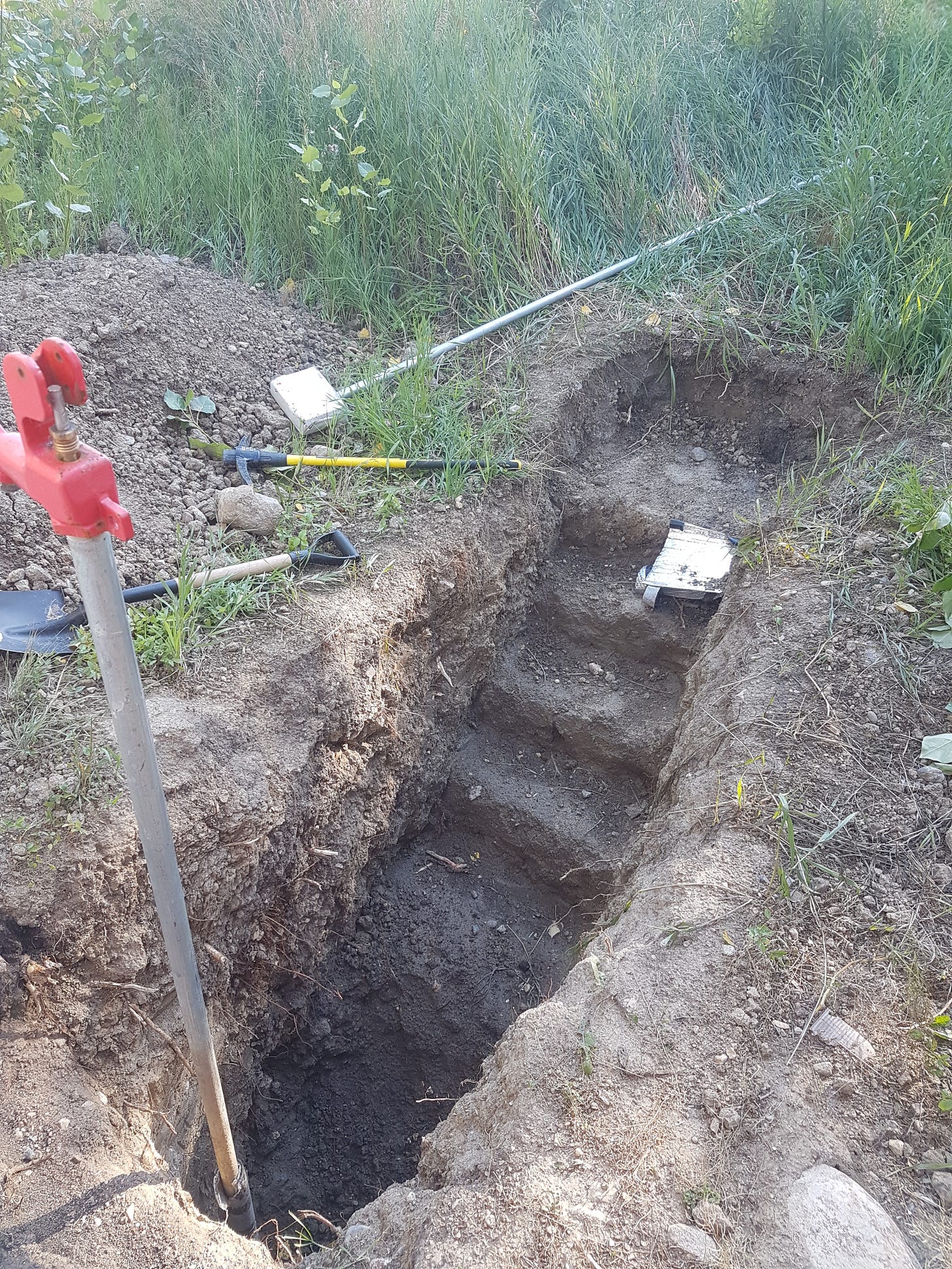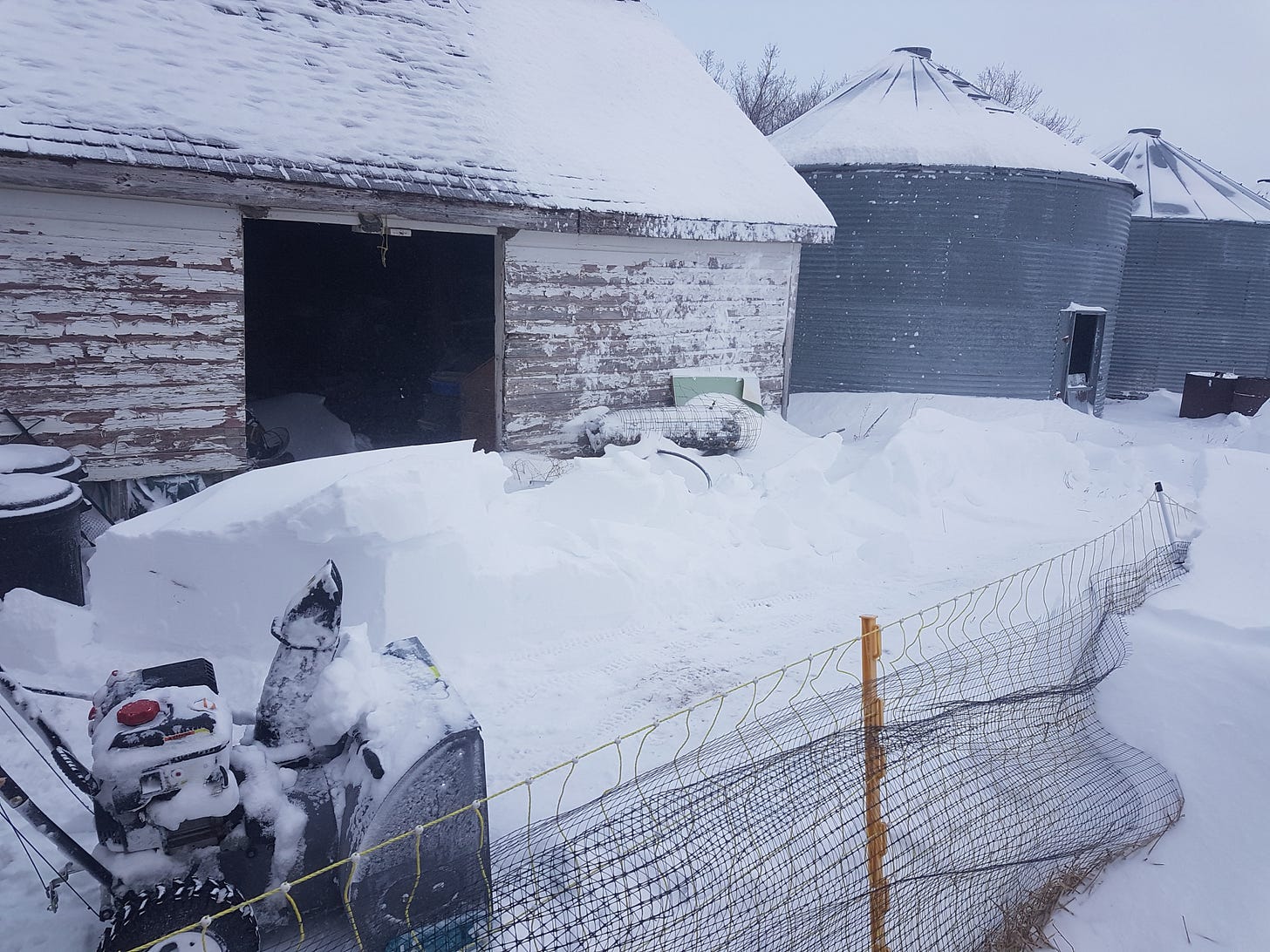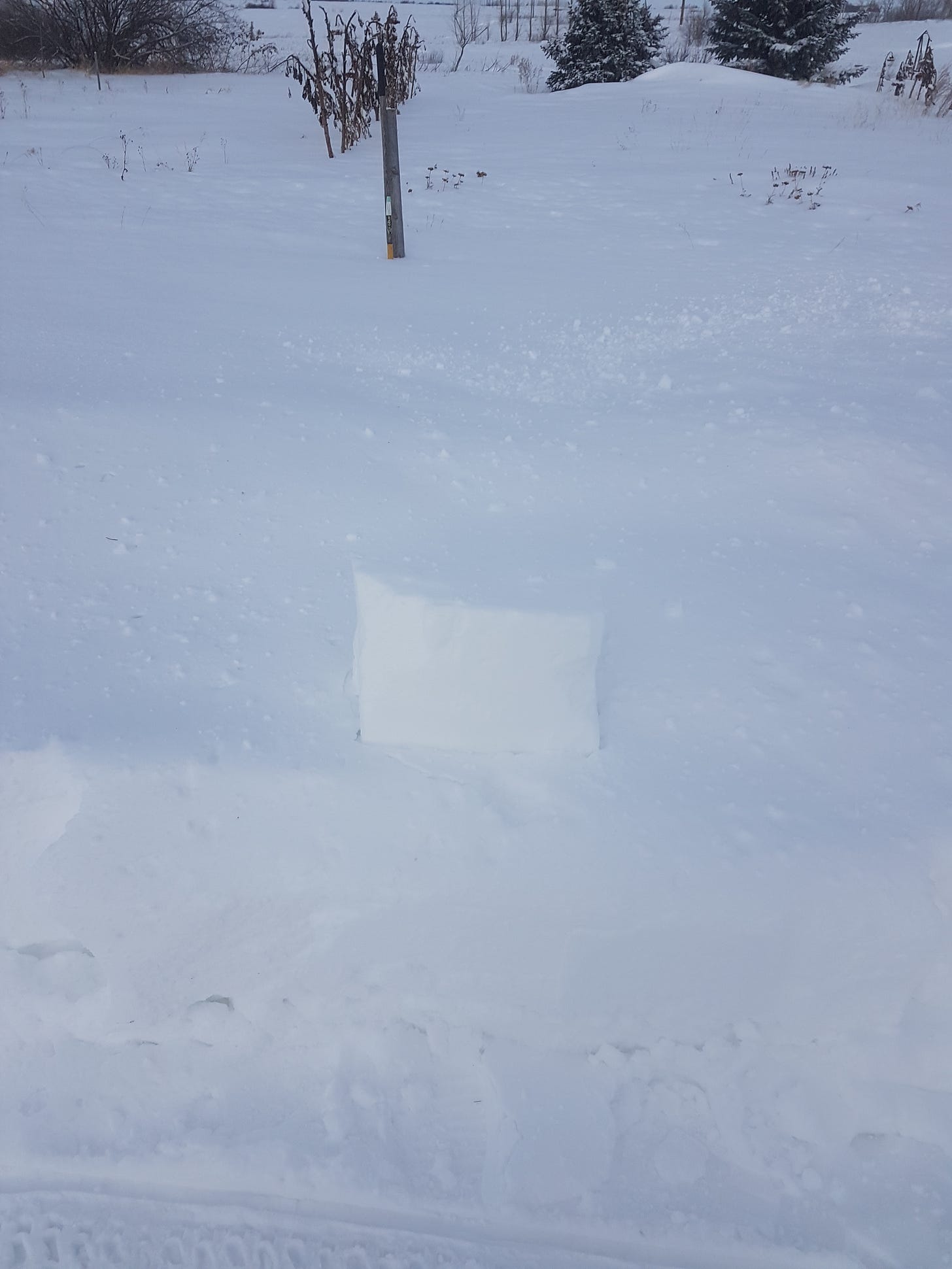Have you ever had a task that became monumental because you really had no idea what you were getting into? It happened to us our second year on the acreage.
Back up just a little; our first winter. Just after New Year’s Day, 2019. We seemed to be having some water issues; lines coughing with air, we thought at first. But after checking down the well, it was much worse: low water table. Possible freezing as well, as the well wasn’t insulated and is quite shallow and silted in after 40+ years.
What to do? We could do laundry in town. Sponge baths. When we wanted a good shower, the indoor pool in Yorkton was our only option, but 40 miles is a long way to go just for that. Jugs of water for doing dishes and cooking (we really hate that stuff, it tastes awful). We did find someone that lent us their water trailer to drop some water down the well from the municipal supply in town, but that didn’t last very long at any one time.
This place doesn’t have an old cistern any more; the old owners had knocked a door into the rainwater cistern that had been there for the school. We use it now for our cold room (it’s perfect for that). There is no other place for water storage either.
Ok, we thought. Let’s see what happens in spring. Well, spring rolled around that first year and runoff filled the well again. All seemed fine that summer, no watering problems for chickens or garden, or for the house either. Maybe it’s just a winter thing? We had a good amount of precipitation for 2019, so we hoped the next winter would be better.
Nope. At some point that winter, things dried or froze up again. The frost-free hydrant out by the barn froze up on us, so we had to haul water from the house for the birds. At least we had installed a wood stove, so it was more efficient to melt snow for some basic needs.
Spring 2020 rolled in, with reasonable rains in the spring. We were saved! It was also the first year we got pigs. Now, pigs don’t drink a whole lot of water, but they sure like their baths! Yes, they can wallow to cool themselves, but it’s not all that critical if they have a good shade shelter and enough water to drink. We were doing the Salatin-style pasture rotation with ours, so a wallow wouldn’t have been possible anyway (it destroys too much ground).
With garden planted and animals out on grass, all seemed to be going just fine. The pigs got to enjoy a shower in the heat of the day (they really look like kids in the sprinkler!). Then the heat came in and didn’t let up. No rain. Early July rolled in from somewhere near Hell, and the well came up almost completely dry.
When something like that happens on a homestead, animals take priority; you get seconds. The garden? Forget it. I had to watch it die a crispy death. We would water in the mornings when the hoses were still cool, and fill extra buckets for everyone until the water dried up. But you know, pigs don’t understand why they can’t have their fun little shower in the heat any more. And we didn’t have a water barrel with nipples on it yet, just a rubber water bowl that they would slurp from then try to wallow in what was left.
The birds did alright, but we couldn’t change the kiddie pool out more than once in the mornings for them and couldn’t put much in it either. As long as they had drinking water and a little in the pool they were fine.
This got us thinking. How the hell did the other people live here and raise three boys, even run a dishwasher, when this well just can’t handle it? And, what could we do to solve this?
Tom made up some dowsing wands (a simple thing, really). If you think that’s all woo-woo stuff, you haven’t seen how it works. My method is even more unconventional, but I have proof it works. Anyhow, Tom got to pacing the yard and found a spot. He said it felt like he was slogging through mud in that place, and he could feel it in his elbow too (he used to dowse for old bottle dumps and has the collection to prove it). He got the impression that there was water about 15 feet down, which would make sense since it would be the same main source as the old well and the location was just a few feet higher in elevation.
Break out the shovels and mattock, buckets and yard wagon. Tom had already picked up a new hydrant, and had also cut a giant door in one of the grain bins in the yard; he also built heavy framing to prevent collapse. The plan for that was to make it into firewood storage and a place to hang animals after slaughter, but these bins were built with inverted concrete cones in the bottom to increase capacity. Two of them (the north and south ones) were compromised and would get wet in the bottom, so were no longer used for grain. We still rented out the middle two for a couple of years yet.
He got to digging in the insane heat and let me tell you: he does not quit easily. He had to cut, and I mean cut, steps in to get down to the bottom of the hydrant. This whole yard is on top of solid clay. There wasn’t room to dig a wide hole between the barn and the shed we used for feed. That dirt got piled up beside the barn wall, owing to the cramped space. We rigged a tripod and windlass to bring up buckets of material, because this got to be nine feet deep and still didn’t find the bottom end of the hydrant.
He didn’t get started on trying for the new well until after digging the hydrant down. He cut a 4x4 foot hole to start with, and started working straight down. Down for nine feet. You couldn’t get much straighter walls with precision tools. He didn’t see any sand mixed into that clay until he got about eight feet deep. Until then, it was solid, unrelenting clay. He got his workout that summer but not in any enjoyable way! I helped again, dumping the buckets brought up on the windlass into the wagon. All that ended up filling a significant portion of the bottom of the grain bin.
Seeing that at the nine foot mark there was a slight increase in the sand mix, we thought we could try a sand point the rest of the way. We picked one up, and had pipe threaded for the sections that would be added as we pounded it in. We picked up a manual post pounder and Tom welded an extra weight on top of it (that made it pretty awkward to handle).
The day came to put this theory to the test. We got out there and started pounding that thing down. It went reasonably well for the first bit, but as expected, it got more difficult the more pipe we had in the ground. Once we got the point down to what we could figure was about 15 feet, we ran a line and weight down the pipe to see if there was anything there. Lo and behold, it came back wet! Now, that didn’t mean there was enough water at that level, but it did mean we were on the right track after all the effort. We wanted to get down a few more feet to be sure to get more into the water table so there would be more capacity.
But the post pounder wasn’t up to the task, and we didn’t have access to other options that we could think of at the time. We ended up having to cover up the well for safety, and it remains that way now. It has partially caved in with the freeze-thaw cycle and moisture. The hydrant is also still unfinished, as we need help with that as well.
We struggled along the rest of that year with low water, then we happened to talk to the people who used to own the place, and they told us they always pumped water from the dugout to the slough by the well every fall. But we didn’t own the hose or pump required; we had to rent them. 450 feet of hose! But we pumped an estimated 120,000 gallons from that dugout, so we were really ok for that winter. We just had to run buckets to the chicken shed all winter.
Winter took it’s time coming that year, but we got absolutely hammered with a massive storm on December 22 that buried the fencing out at the chicken run. I think though that our snowfall totals for that winter were a little on the lower end, so we weren’t too sure how much that would help through the summer.
Spring seemed to come pretty early, but we got hit with a pretty big snowstorm again in the middle of April 2021, then rains were pretty steady and heavy into the summer. This made us think we shouldn’t need to run extra water from the dugout in the fall. Wrong.
Winter of 2021-2022 was something else altogether. It came in around the normal time, around the end of October or early November. But it was unrelenting. Storm after storm hammered us with endless snow. It seemed we were clearing snow every three days. We were getting pretty exhausted, and our walk-behind snowblower was punching far above its weight with the snow pack. It sheared a pin in the middle of one episode and we didn’t have extra ones around, so we had to run to town for that.
And wouldn’t you know it, the well quit again. At least there was no shortage of fairly clean snow to melt, and we had plenty of buckets to set by the stove. We packed those buckets really well to get the most out of each load. Normally, the ratio of snow to water is about 5 to 1, but I think we managed to do better than that. Constant filling of a couple of large stock pots on the stove along with keeping full buckets beside the stove, and we managed almost 20 gallons of water per day. Good for toilets and chickens, sponge baths when you heat some up. We just had to boil and filter for drinking water or run to town for the other stuff and to do laundry.
Then came January 21, 2022. We were hit with a storm that rivaled those of 1947-1948 and 1977-1978. If you were around for those years, you know what I mean. We got buried, while being under the fiercest wind we had seen outside a tornado. Our weather anemometer recorded gusts up to 63kph, and that may have been hampered by the snow itself. An old-fashioned prairie blizzard. Many parts of North America were hammered hard that year so we were not special in that regard. We woke up the next morning to several feet of snow that would have been entirely suitable to build igloos out of.
We dug our way slowly out of that for the most part, but I seem to remember trading some of our chicken in the freezer for the neighbor to come properly clean out the driveway with his tractor. The rest of the winter kept on dumping snow on us and it didn’t let up until April. Snow didn’t disappear until nearly May. But between the crazy amount of snow and later rains, we fared much better with the well in 2022 and didn’t need to transfer water that fall.
Following years were better, though we decided to do a transfer in fall of 2023 just in case; the water table looked a little lower than we thought feasible to carry through the winter. 80,000 gallons this time and we were safe. 2024 we didn’t do anything because we weren’t going to keep birds through the winter.
But we did end up with a temporary tenant in December 2024 through April 2025, and from about mid-January to the end of March we had to cut water usage somewhat to keep from running out in the middle of something. It managed to supply us enough for most things and we could run small loads of laundry or get a really quick shower if it was the only large-volume usage for the day. All good once we got warm weather coming in; March turned really nice towards the end of the month.
All this to say, we still haven’t finished what we started five years ago! We might see if we can get a backhoe in to push that sand point down further; the hydrant is deep enough that even a mini-trackhoe won’t reach far enough down. We did pull down the old feed shed last year, so the neighbor with his Cat 320 trackhoe can actually get in there and dig it down for us.
I’ll have to write the saga of seasonal events in more detail sometime later, because some of it deserves a little more attention. Between the ups and downs of homesteading, trying to run our own business, health crises, hunting stories…should I write a book?
All of my content is free, but I do offer paid subscriptions for anyone who would like to support my work. If a one-time contribution is more appealing, use the “Tip Jar” below to give any amount you like. If you’re not ready to commit but enjoyed reading this post, you can follow, hit the like button, leave your thoughts in the comments, or restack to spread the word.
To see more stories in this category, go here: Our Stories & History
To see all my categories, go here: Newsletters









